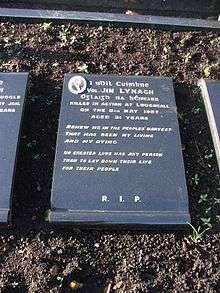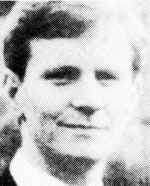Jim Lynagh
| Jim Lynagh | |
|---|---|
|
Jim Lynagh | |
| Born |
13 April 1956 County Monaghan, Republic of Ireland |
| Died |
8 May 1987 (aged 31) County Armagh, Northern Ireland |
| Other names |
Séamus Ó Laighneach "The Executioner" |
Jim Lynagh (13 April 1956 – 8 May 1987) from Monaghan Town, County Monaghan, Republic of Ireland, was a volunteer in the East Tyrone Brigade of the Provisional Irish Republican Army (IRA).[1]
Background
One of twelve children, Lynagh was born and raised in Tully Estate, County Monaghan in the Republic of Ireland.[2] He joined the Provisional Irish Republican Army in the early 1970s. In December 1973 he was badly injured in a premature bomb explosion, arrested, and spent five years in the Maze Prison.[3] While imprisoned, he studied and became a great admirer of Mao Zedong.[4] After his release from prison in 1979 Lynagh was elected as a Sinn Féin councillor for Monaghan, and held this position when he was killed.[3][5]
East Tyrone Brigade
After his release from prison Lynagh became active in the IRA again, serving with the Provisional IRA East Tyrone Brigade. He quickly became a unit commander and gradually built up his ruthless reputation. After a series of Ulster loyalist attacks against Irish nationalist politicians in late 1980 and early 1981, Lynagh was suspected of involvement with an attack on the Stronge estate near Middletown. The IRA killed the retired Ulster Unionist Party Stormont speaker, Sir Norman Stronge, and his son James, a Royal Ulster Constabulary (RUC) officer, before burning down their mansion, Tynan Abbey, and shooting their way through a police cordon.[3][6]
Lynagh was known as "The Executioner" by the RUC.[7] He was picked up and interrogated many times by the Gardaí in Monaghan but was never charged. During this time he devised a Maoist military strategy adapted to Irish conditions, aimed at escalating the war against British forces. The plan envisaged the destruction of police and British Army bases in parts of Northern Ireland to create liberated areas under IRA control. In 1984 he started co-operating with Pádraig McKearney who shared his views. The strategy began materialising with the destruction of a RUC police station in Ballygawley in December 1985 which killed two RUC officers, and in The Birches in August 1986.
Death
Lynagh was killed in the Loughgall Ambush by the Special Air Service on 8 May 1987 during an attack on Loughgall RUC barracks, his third attack on an isolated rural police station. Lynagh's men detonated a 200 lb bomb and engaged in a fire-fight with the security services. Lynagh and the seven other members of the IRA team who were killed became known as the "Loughgall Martyrs" to Irish republicans.[5]
Lynagh was buried in Monaghan Town following an incident where Garda Special Branch officers were attacked by a crowd of mourners.[8][9]

References
- ↑ CAIN Web Service
- ↑ Moloney, Ed (2002). A Secret History of the IRA. Penguin Books. p. 306. ISBN 0-14-101041-X.
- 1 2 3 Urban, Mark (1993). Big Boys' Rules: SAS and the Secret Struggle Against the IRA. Faber and Faber. p. 223. ISBN 0-571-16809-4.
- ↑ Armed Struggle: a History of the IRA by Richard English, page 254
- 1 2 Henry McDonald (29 September 2002). "True tale of IRA 'martyrs' revealed". London: The Guardian. Retrieved 5 March 2007.
- ↑ "Donaldson 'killed to avenge SAS killing'". BreakingNews.ie. 9 April 2006. Retrieved 5 March 2007.
- ↑ Sean Rayment (5 November 2005). "SAS prevented an outrage but now fears prosecution". London: The Daily Telegraph. Retrieved 5 March 2007.
- ↑ Tírghrá, National Commemoration Centre, 2002. PB) ISBN 0-9542946-0-2 p.291
- ↑ Dáil Éireann – Volume 372 – 13 May, 1987 Statements. – Incident at Emyvale, County Monaghan Dáil Éireann Debates
